 Colonel: commands a regiment of artillery (72 cannons and 1,840 men).
Colonel: commands a regiment of artillery (72 cannons and 1,840 men).

 Lieutenant Colonel: the Colonels second-in-command commands the regiment in the absence of the Colonel.
Lieutenant Colonel: the Colonels second-in-command commands the regiment in the absence of the Colonel. 
 Major: a staff officer at the battalion level.
Major: a staff officer at the battalion level.

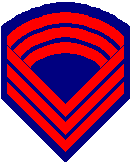 Sergeant Major: the battalion orderly Sergeant, the senior NCO in the battalion.
Sergeant Major: the battalion orderly Sergeant, the senior NCO in the battalion. 
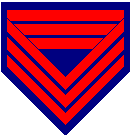 Regimental Quartermaster Sergeant: Issues clothing, equipment, and rations to the men of the regiment with the help of the Battery
Quartermaster Sergeants.
Regimental Quartermaster Sergeant: Issues clothing, equipment, and rations to the men of the regiment with the help of the Battery
Quartermaster Sergeants. 
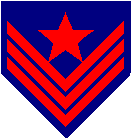 Ordinance Sergeant: in charge of all of the ordinance in the battalion. He insures that the batteries get the proper type and amount of ammunition.
Ordinance Sergeant: in charge of all of the ordinance in the battalion. He insures that the batteries get the proper type and amount of ammunition. 
 Captain: commands a battery (6 cannons and 152 men).
Captain: commands a battery (6 cannons and 152 men).
The Captain had overall command, control, and responsibility for the training, serviceability, and combat operation of the battery's personnel and equipment. He was not only the chief recruiter of the battery, but also used his influence to acquire horses and other material, through means outside normal requisitions, to keep his battery in the best possible condition. Depending on the organization of the army at a particular time, the Captain received his orders from either an artillery battalion commander, a division "Chief of Artillery", or an infantry brigade commander; ranking from Major to Brigadier General respectively. The Captain had command over as many as 152 men and 98 horses in a six-gun battery with six horse teams. In a four-gun battery with four horse teams he had to have a minimum of 71 men and 45 horses to function efficiently. Most artillery officers were very slow to receive promotion due to the relatively light casualties and "turnover" in the long arm as compared to the infantry.

 First Lieutenant: commands a section (2 cannons) and is the Captains second-in-command, commands the battery in the absence of the Captain.
First Lieutenant: commands a section (2 cannons) and is the Captains second-in-command, commands the battery in the absence of the Captain.
The First Lieutenant had command of, and responsibility for, their respective sections consisting of two half-sections (40 men top average), and their equipment (two cannon, two caissons, four limbers, and 20 to 30 horses). The section leaders received their orders from the Captain and performed various additional duties such as: brigade/division artillery inspector; requisitioning ammunition, clothing, harness, tools, and tentage; battalion officer of the day. Occasionally a section from a battery was ordered out on picket duty or a special detail with a small infantry force. This gave the Lieutenant good training and experience in independent command - a chance to catch a commander's eye. Lieutenants were often assigned to supervising the construction of small bridges or earthworks. On the march they rode abreast of their sections to keep the proper intervals and to check straggling. During battle a section leaders sometimes dismounted to direct his section's fire on order of the Captain, otherwise he directed the section from horseback. All officers as well as Sergeants were mounted in a field battery, many times on their personal mounts. In the event the Captain was absent, the senior Lieutenant took command of the battery. In many instances, especially in four gun batteries, when a senior Lieutenant took the command permanently he was not promoted, but finished the war as senior First Lieutenant, Commanding.

 Second Lieutenant: commands the line of caissons.
Second Lieutenant: commands the line of caissons.
The junior officer of a battery had command of, and responsibility for, all the caissons and ordnance (cartridges and projectiles). The personnel under his direction included the Chiefs of the Limbers (junior Corporals), the drivers, and any extra men assigned him. This officer was also frequently assigned the additional duty of adjutant. During battle his duties were to insure maximum protection of the caissons, their teams, and his men from hostile fire - yet keep them in close enough proximity to the battery and battle lines that the demand for ammunition could be satisfied quickly.

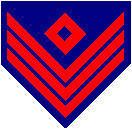 First Sergeant: the battery orderly Sergeant and the senior NCO in the battery. He represents the enlisted men in front of the officers.
First Sergeant: the battery orderly Sergeant and the senior NCO in the battery. He represents the enlisted men in front of the officers.
The ranking staff NCO (Non-Commissioned Officer) worked for, and answered to, the Captain only. He carried out all details desired by the Captain that pertained to the battery, not an individual segment of it. He assisted the Captain in the supervision of the battery's operations and was responsible for the administration work of the battery. He prepared reports, called roll, maintained the fatigue and duty rosters, and made recommendations on personnel actions. He also assigned, assisted, supervised, and checked the various details such as: posting guards, equipment repair, stable call, and horse grooming. He was the overseer of training and discipline, and instructed the Sergeants on their NCO duties. During battle he had no combat station, but stayed near the Captain and carried out any orders issued him. If the battery happened to be short an officer due to leave, sickness, or death, the First Sergeant took up the duties of the Chief of the Line of Caissons by direction of the Captain. He remained assigned until a replacement was transferred in, or more often, he was elected and/or permanently promoted the junior Lieutenant. Only in extreme necessity would the First Sergeant have command of a section.

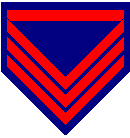 Battery Quartermaster Sergeant: Issues clothing, equipment, and rations to the men of the battery.
Battery Quartermaster Sergeant: Issues clothing, equipment, and rations to the men of the battery.
This staff NCO received his direction from the First Sergeant or the Captain. As the Quartermaster Sergeant he was responsible for drawing and issuing clothing, personal gear, rations, and sometimes small arms ammunition to the enlisted men of the company, and kept the appropriate records. In some instances in a four-gun battery with limited manpower, the Second Sergeant took up the duties of a Quartermaster Commissary Sergeant, in addition to his command of a half-section. The Quartermaster Sergeant had charge of all details concerning the teamsters and their wagons. When drawing Quartermaster supplies the details traveled to a depot or storage site, loaded the wagons, and returned to camp, a trip that sometimes took several days. In battle the Quartermaster Sergeant, like the First Sergeant, had no combat assignment. He was to keep with the commander and carry out any orders issued him. However, most often he was detailed to remain with the baggage or supply wagons assigned the battery or the parent artillery battalion and see to their safe keeping. Some batteries, especially Union six-gun companies, had a separate Commissary Sergeant to handle rations. 
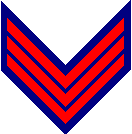 Sergeant (Chief of Piece): commands one gun and its limber.
Sergeant (Chief of Piece): commands one gun and its limber.
The Sergeant had command of, and responsibility for the men and equipment of a half-section. The personnel consisted of the gunner and his cannoneers, and the Chief of the Limber and his drivers. The equipment under their control was one cannon, 9 to 13 horses, and all their harness and saddles. The Sergeant assigned all duty positions in his half-section, except for the Corporals, and he insured that the cannoneers and drivers were not only properly trained, by that they could switch roles on an individual basis if necessary. During battle he dismounted, leaving his horse with the drivers, and took his post in rear of his piece. In action he was to follow, repeat, and carry out the Section Leader's orders promptly; insure that the Gunner selected the correct target and used the proper range and projectile; check that the Chief of the Limber was prepared to send forward ammunition as necessary; and see that downed horses were unharnessed and replaced as the situation dictated. On the march he rode beside the left lead horse and performed duty as guide for his half-section. The Sergeants were ranked in order of seniority, i.e., Second Sergeant, Third Sergeant, Fourth Sergeant, etc.

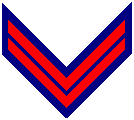 Corporal (Gunner): commands the cannon only, in charge of aiming the cannon and the five privates under him.
Corporal (Gunner): commands the cannon only, in charge of aiming the cannon and the five privates under him.
The Gunner had command of, and responsibility for the men and equipment of a gun detachment. The detachment personnel consisted of the cannoneers (a minimum of six, maximum of ten) and the equipment included one cannon. On the road they marched near their pieces with their cannoneers. Here they were able to check straggling and work to keep their respective pieces well up in traveling order. During battle each carried out the orders of his Chief of the Piece. He aimed and sighted the piece and gave the orders for its combat firing. According to the Section Leader he controlled the rate of fire, much of which depended on the quick sighting of the piece, as this usually took longer than the loading operation due to the recoil. The Corporals, like the Sergeants, were in order of seniority. The senior half of the Corporals were the Gunners, the junior half the Chiefs of the Limber. 
 Corporal (Chief of Limber): commands the limber, in charge of the ordnance in his limber and makes sure that the cannon gets the right round with the proper fuse setting.
Corporal (Chief of Limber): commands the limber, in charge of the ordnance in his limber and makes sure that the cannon gets the right round with the proper fuse setting.
The junior Corporalís primary job was the care of the limbers and caisson, especially in seeing that the ammunition in them was properly packed and in good condition. These Corporals had limited authority over the drivers of their respective half-sections, but the drivers were first subject to the wishes of the Chief of line of Caissons and the Chief of the Piece. As far as the drivers were concerned, his main duty was to insure they kept proper care of their animals and the harness in their charge. On the road he marched near the caisson; only infrequently was he mounted. In battle he helped direct the caisson of his half-section into a secured position as directed by the Chief of line of Caissons. Once reaching the position he, with any extra men assigned, readied ammunition for transfer to the forward limber. Many times he is referred to as the "Chief of the Limber." 
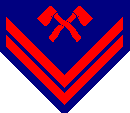
 Corporals and Privates (Pioneers): Working-parties that are attached to batteries to mend roads, remove obstacles, and erect defenses.
Corporals and Privates (Pioneers): Working-parties that are attached to batteries to mend roads, remove obstacles, and erect defenses.

Privates (Cannoneers)
Had active participation in the loading and firing of the piece they were assigned, and were trained according to numbers that described the duties of each particular gun position. Though each was trained in a priority position, they were generally trained on all positions and also that of driver. The cannoneers received their battle commands from the Gunner with the Chief of the Piece supervising the overall action of the detachment. On campaigns they marched aside their respective piece and were continually lending muscle to the pieces in mud, snow, swamps, and steep grades. In emergencies and on order of the Captain, they mounted the limbers and caissons for quick transportation or disposition on the battlefield. This mode was not used, however, on ordinary marches or while under artillery fire. Horses quickly fatigued with the added weight and by 1862 both armies issued general orders for the cannoneers to march with their pieces.
Privates (Drivers)
Are the horsemen or riders that played an active part in moving the ordnance equipment. Each driver had two horses and their harness under his care. Each rode the left horse of his team and was held responsible for the feeding, watering, and grooming of the team. They were usually picked for this duty because of their knowledge or skill with the animals. During battle they brought the cannons into position under the direction of the Sergeant (Chief of the Piece). The caisson drivers were directed into position by the chief of line of caissons, frequently taking position under hostile fire. Keeping the horses calm during battle and removing harness from downed horses was a skill of the drivers often used. The drivers had to be alert at all times in case the ordnance had to be removed from its position in haste. However, once the artillery line was established the drivers would often dismount and lay on the ground with their reins in their hands, depending on the amount of hostile fire being received. Though they were not 'up front', artillery generally had the tendency to shoot high, causing consternation among the drivers trying to control horses just in rear of the main battle line. The only drivers that were not usually with the battery in battle were those that drove the traveling forge and battery wagon. This equipment was usually in the rear of the army on the march.
Privates (Teamsters or Wagoneers)
Were under the direction of the Quartermaster Sergeant and were assigned to drive and care for the baggage wagons (normally two), forage wagons, and sometimes an ambulance. Most of these men were paid an extra rate. These men were considered important not just because they looked after the baggage, but they guarded it with zeal from other troops and commands. Forage and corn for the horses were a much sought after commodity - sometimes by starving infantrymen. Under their care were the wagon teams of either two or four animals, usually mules and their harness. On the march they were in rear of the battery and sometimes in rear of the army in the baggage train. Also, these men and the extras handled and cared for the extra horses belonging to the battery. Normally a battery would have from four to eight men detailed to this duty; sometimes it was rotated, but often not. Often the teamsters were detailed to the battalion or brigade quartermaster, especially in the later part of the conflict. Many times these men were railed as shirkers from the fighting part of the army. In part this was true, but they performed a valuable service and most did their duty to the end, and even though they did not relish front line positions, they contributed.
Privates (Artificer & Farrier)
These men were specialists who were paid an additional rate like teamsters. In winter camps and during lulls in active campaigning they broke out their tools from the battery wagon and forge and went to work. The artificer was primarily a blacksmith - he repaired the wood and iron parts of the battery carriages. The farriers specific task was to keep all the horses and mules shod - a large task considering the number of animals in a battery. There is some evidence that a few batteries had an artificer assigned to each half-section. However, most records indicate that only two men, or a maximum of three, were assigned this duty in a single battery. They received their instructions from the First Sergeant and traveled in the rear of the battery near their tools.
Privates (Spare men)
Almost all batteries retained a number of extra men above the minimum required for the battery to function properly. These men were assigned to the detachments for training and for quick replacement of battle casualties, hospitalized sick, and furloughed men. Usually the complement was placed under charge of the chief of line of caissons and remained with the caissons during active campaigning. Occasionally some of these men were detailed to the Quartermaster Sergeant. The First Sergeant also used them as a ready pool of manpower when the battery was in drill status so miscellaneous work could be accomplished. This position was not an official assignment nor were men placed here in a permanent status. Cannoneers and drivers were constantly absent for various reasons and these men were quickly rotated into an open slot. All privates were supposedly trained in the duties of cannoneer and driver.
Privates (Musicians)
Though batteries were authorized as many as three musicians, the complement was usually no more than one or two buglers. The primary bugler was assigned to the captain's staff, was authorized to be mounted, and kept close to the Captain's Headquarters at all times. Soldiers of a battery were quick to learn the calls of the bugle, and on a routine day at least four and as many as ten were made. Over the noise of battle the bugle was also heard to sound 'In Battery', 'Commence Firing', and 'Cease Firing' on the captain's command. In the morning many batteries preferred 'Boots and Saddles' over the more common 'Reveille'. Being on the commander's staff the bugler was given other tasks and duties. Many were assigned as orderlies or clerks.
Privates (Guidon)
The color bearer, more appropriately the guidon bearer, held a position on the captain's staff akin to the bugler. The importance of the guidon is realized when considering that armies of the day maneuvered on small parcels of land with thousands of troops. Coupled with road dust, confusion, and battle smoke, the battery's sections needed a marker the guides (Sergeants) could see so they could direct their detachments on the march and onto the battlefield. The guidon fulfilled this need by indicating the direction of march the Captain wanted taken. When arriving at a position to form a battle line, the guidon first halted to establish the right or center of the proposed line. The guidon's official position in battle was supposed to be on the right, left, or center of the line of caissons, or 35 yards in rear of the cannon muzzle line. As the war progressed this position was modified to the center of the limbers, 20 yards in rear of the guns. The color bearer himself was selected on special trust and confidence by the officers. His duties required that he be mounted, and in camp he was given duties as an orderly or clerk. In camp the colors were furled and cased to protect them from the elements and usually kept in the officer's quarters. The importance of the banner as a device of esprit de corps need not be discussed here.

This page last updated: May 26, 2005
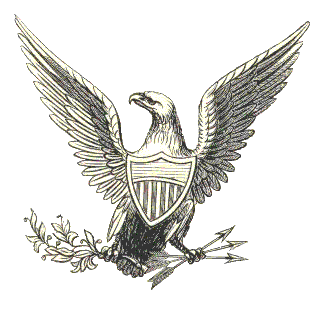

 Colonel: commands a regiment of artillery (72 cannons and 1,840 men).
Colonel: commands a regiment of artillery (72 cannons and 1,840 men).  Lieutenant Colonel: the Colonels second-in-command commands the regiment in the absence of the Colonel.
Lieutenant Colonel: the Colonels second-in-command commands the regiment in the absence of the Colonel.  Major: a staff officer at the battalion level.
Major: a staff officer at the battalion level.
 Sergeant Major: the battalion orderly Sergeant, the senior NCO in the battalion.
Sergeant Major: the battalion orderly Sergeant, the senior NCO in the battalion.  Regimental Quartermaster Sergeant: Issues clothing, equipment, and rations to the men of the regiment with the help of the Battery
Quartermaster Sergeants.
Regimental Quartermaster Sergeant: Issues clothing, equipment, and rations to the men of the regiment with the help of the Battery
Quartermaster Sergeants.  Ordinance Sergeant: in charge of all of the ordinance in the battalion. He insures that the batteries get the proper type and amount of ammunition.
Ordinance Sergeant: in charge of all of the ordinance in the battalion. He insures that the batteries get the proper type and amount of ammunition.  Captain: commands a battery (6 cannons and 152 men).
Captain: commands a battery (6 cannons and 152 men). First Lieutenant: commands a section (2 cannons) and is the Captains second-in-command, commands the battery in the absence of the Captain.
First Lieutenant: commands a section (2 cannons) and is the Captains second-in-command, commands the battery in the absence of the Captain.  Second Lieutenant: commands the line of caissons.
Second Lieutenant: commands the line of caissons.  First Sergeant: the battery orderly Sergeant and the senior NCO in the battery. He represents the enlisted men in front of the officers.
First Sergeant: the battery orderly Sergeant and the senior NCO in the battery. He represents the enlisted men in front of the officers.  Battery Quartermaster Sergeant: Issues clothing, equipment, and rations to the men of the battery.
Battery Quartermaster Sergeant: Issues clothing, equipment, and rations to the men of the battery.  Sergeant (Chief of Piece): commands one gun and its limber.
Sergeant (Chief of Piece): commands one gun and its limber.  Corporal (Gunner): commands the cannon only, in charge of aiming the cannon and the five privates under him.
Corporal (Gunner): commands the cannon only, in charge of aiming the cannon and the five privates under him. 
 Corporals and Privates (Pioneers): Working-parties that are attached to batteries to mend roads, remove obstacles, and erect defenses.
Corporals and Privates (Pioneers): Working-parties that are attached to batteries to mend roads, remove obstacles, and erect defenses.